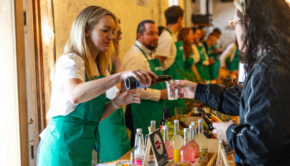Working harder and gaining less

Fionnuala Carolan and Gillian Hamill sense the general mood of suppliers and retailers within FMCG in the continued challenging environment.
15 September 2010
 Last November ShelfLife carried out a survey to determine the mood of Irish suppliers. With rumours of bullying and unfair practices rife, we wanted to hear directly from those in the industry if things were indeed as bad as were being claimed. Through our anonymous survey, we were able to understand the main gripes and genuine worries from inside the industry. A surprising 95% of suppliers surveyed last year admitted they were coming under increased pressure to supply goods to retailers under unfavourable terms. Dunnes Stores were said to be the most severe with its demands while Tesco had been the main perpetrator in delisting products.
Last November ShelfLife carried out a survey to determine the mood of Irish suppliers. With rumours of bullying and unfair practices rife, we wanted to hear directly from those in the industry if things were indeed as bad as were being claimed. Through our anonymous survey, we were able to understand the main gripes and genuine worries from inside the industry. A surprising 95% of suppliers surveyed last year admitted they were coming under increased pressure to supply goods to retailers under unfavourable terms. Dunnes Stores were said to be the most severe with its demands while Tesco had been the main perpetrator in delisting products.
So we decided to revisit this issue and spoke to a number of suppliers and also to retailers about how they are feeling now. The mood is mixed with some feeling that things are improving slightly but others claiming conditions are the same or even deteriorating further.
When asked whether they were still feeling pressure from the multiples we got some surprising answers. Rather than feeling victimised, a number of suppliers are saying that they have to be responsible for staying in business by being competitive. “We producers/suppliers need to become more cost efficient,” according to one supplier.
After being asked if any goods were replaced by non-Irish brands another supplier says: “Why should any multiple pay more to an Irish supplier if he can buy cheaper… Nobody owes us a living.”
A small number of suppliers even say that they have noticed an increase in sales in the past year with one claiming a 4% increase, while another has seen a 26% increase.
However the finger was also being pointed at the multiples for using cheap alcohol as a way of enticing customers in store. One supplier notes: “Multiples using alcohol as a loss leader is hurting the sector as a whole not to mention its effect on society with increased levels of alcohol abuse.”
Funding promotions
When asked if they were still being expected to fund retailer promotions, suppliers say practices such as “pay to play money” “insert monies”, “end space monies” and “flyers” were still common requests by large multiples.
One supplier certainly isn’t happy with the treatment he is receiving at the hands of the multiples: “They have become more aggressive, more demanding and are still not prepared to reduce their margins, by and large the supplier 100% funds promotions.”
In one instance both suppliers and retailers are facing the same problem. They are seeing increased sales yet they are making less money because goods are being discounted so heavily. “We’ve seen increased sales but decreased value, i.e. more ‘on sale’ sales. We have dropped prices by approx 16%, volume has increased significantly.”
Here is a list of other gripes put forward by some suppliers when asked what practises are common:
• “One of the multiples decided to sell one of our SKUs at below the RRP, the other reduced to the same level and demanded we fund the loss of their margins”
• “All promotions are now subject to large contributions meaning deminished profitablity.”
• “We are asked for ‘marketing support’ every year”
• “Promotions are always supplier funded”
• “Margin maintenance at lower shelf prices (matching competitors)”
• “Extra shelf funding and bigger Lomg Term Agreements (LTAs).”
Delisting
One quarter of suppliers we spoke with said they felt like they weren’t supported by Irish supermarkets this year and 50% said they had products replaced with non-Irish products. A number of suppliers found that they had products delisted since the beginning of the year.
“A number of lines were delisted when we entered Dunnes Stores Central Distribution Centre”, says one disgruntled supplier.
Code of practice
The Grocery Code of Practice is being brought in to protect everyone in the chain but especially those who are most vulnerable to demands by the large supermarkets. However some suppliers don’t seem to be convinced that it will change the dynamics between them and the multiples or that its rulings will be taken seriously.
One supplier comments that he is “not convinced it will have any teeth”.
The view from the shop floor
The last few years have been a testing time for many businesses. Retailers in small to medium size businesses around the country have had plenty of things to worry about from rent costs, wage bills and constant promotions being pushed by the groups with little to no margin attached.
The National Consumer Agency(NCA) has been warning Irish consumers that they need to keep shopping around for value and suggesting that retailers are price fixing.
“Competitive pricing is still not a feature of the Irish grocery market,” says National Consumer Agency (NCA) chief executive Ann Fitzgerald, on the grounds that “the most powerful retailers in the State…are still price matching in core branded items to a significant degree.”
“To address this there is a real need for a new entrant to the market to offer consumers a real alternative,” she argues. At present, the debate continues to rage on the subject of relaxing Ireland’s retail planning guidelines to allow such a competitor to enter our shores. However ShelfLife spoke to a number of retailers across the FMCG spectrum and found out that the country’s existing grocery and convenience outlets have made unarguable strides to offer more value.
100% increased promotions
All the retailers questioned by ShelfLife said they now carry more promotions than they did one year ago. Yet in saying that, there was no broad consensus reached on the number of extra promotions retailers now feature on their shelves. While 26% said they now carried 1-10 more promotions, at the higher end of the scale, a significant 16% said they now featured 50 plus more promotions in-store.
What’s more the majority of retailers answered that their prices had fallen by an average of 11-15% over the past year. This accords with NCA research that showed the price of branded goods fell by an average of 14% from January 2009 to July 2010. However, a further 21% responded prices had fallen by just 0-5%, 26% said they had dropped by 6-10%, while another 5% reckoned they’d been slashed by an impressive 16-20%. Surprisingly, considering the current climate, 11% of retailers said prices hadn’t fallen.
Tallying up
So, has this general strategy of greater promotions and lower prices yielded returns for retailers? Unfortunately, while these tactics might have helped boost customer loyalty and aided stores in retaining market share over their competitors, the majority reported turnover had decreased in the past year. Most (37%) found turnover dropped by 11-15%.
Despite reports of rising food costs, the news is not all bad when it comes to overheads though, with a significant number of retailers finding the cost of their overall overheads remained approximately the same over the past year. Unfortunately, 63% reported their overheads increased, while just 5% said they had fallen. Over half of retailers noted the price of stock had dropped, yet no-one reported rates decreased. In fact, one person said that “rates went up three times last year.”
Another retailer made the valid point that “all major savings were gained the previous year with not much more left to reduce to try and survive in this economy.” Indeed, perhaps because most retailers had taken steps to curtail their wage bills where possible last year, a reassuring 74% of retailers said they did not have to implement redundancies in the past year. Of the 26% who answered that they were forced to take this course of action; 50% said they were forced to let 1-4 staff go, 33% said they had to let 5-8 staff go, and the remaining 17% said they had to introduce 9-15 redundancies. Another individual retailer observed that by reducing staff numbers by a third, they managed to achieve a saving of €50,000 per annum and by decreasing rent by 15%, saved a further €40,000.
Some good news
Pay cuts didn’t affect all retailers across the board this past year either. In fact the situation was almost a 50/50 split, with 53% of retailers reporting they hadn’t introduced pay cuts this year, while 47% said they had. The positive news moreover was that 50% of retailers actually hired new staff. Of those, half hired 1-4 new staff members, 40% hired 5-8 more people, while 10% employed 20+ new staff. In news that should reassure customers, the most popular explanation given was that 40% of retailers wanted better customer service and shop standards. And proving the goal of expansion hasn’t yet croaked; 30% of those who gained new staff said they had acquired new premises, while 20% reported they’d expanded their existing premises.
Meanwhile, John Bryan, the president of the Irish Farmers’ Association, has been working hard to promote the message that farmers receive only one-fifth of the retail price of goods. “It is clear there is an urgent need to restore equity to the food supply chain, with average farm incomes a deplorable €e12,000 and the retail multinationals making huge profits,” he commented earlier this year. However it would appear that some retailers still believe there’s some truth in the old adage, ‘where there’s muck, there’s money’, because while the majority (58%) said they believed farmers should be paid more for the goods they provide, 32% said no, they didn’t agree, while 11% weren’t sure.
It has also been well publicised that Tesco, Superquinn and Lidl all staunchly oppose the government’s proposals to introduce a grocery code of practice and ombudsman, yet 68% of ShelfLife’s respondents said they would be in favour of these measures, while 16% were not, and a further 16% were unsure about the plans.
Clouds on horizon
So instead of viewing a code of practice and ombudsman as representing the greatest threat to the Irish grocery sector (although 16% incidentally do) what do retailers believe is currently casting the greatest shadow over the FMCG horizon? The top two concerns (each securing 63% of the overall vote) were Joint Labour Committee (JLC) wage rates and unsurprisingly, consumers’ reduced budgets. On the former issue, one retailer commented: “If I could pay the legal minimum wage, I would have five more staff employed immediately.” Another individual said the bank represented the number one threat. “Non Irish banks are making life very hard for retailers offering no leeway whatsoever. JLC rates are to increase in January, and we cannot reduce working hours any more without impacting on service, thus prices may have to rise to cover the cost of same.”
The next greatest perceived threat was the ‘power of major supermarkets,’ coming in at 53% of the vote, followed by the potential removal of the current retail cap at 47%. “Tescopilisation of the country will kill independent retail,” one respondent said. Interestingly, in an earlier question, 47% of retailers said they agreed with the NCA’s belief that the four major supermarkets, Tesco, Dunnes, Supervalu and Superquinn, are guilty of price-matching, while 37% disagreed with these claims, and 16% said they weren’t sure.
And one retailer said the NCA actually represented the greatest threat because “wrong, unfair information was being published, with too many convenience stores and cafes competing for the same business.” Another retailer commented that “no one regulatory body supports the retailer in trouble…if it wasn’t for the support of my group Costcutter, 45 jobs would be gone.”
The factors which represented less of a threat however were the rise of own brand goods, decline of paid-for newspapers, and Northern Irish competitors. The reduced competition posed by the latter suggests Irish retailers’ policy of higher promotions and lower prices has at least earned some measure of success.



 Print
Print






Fans 0
Followers